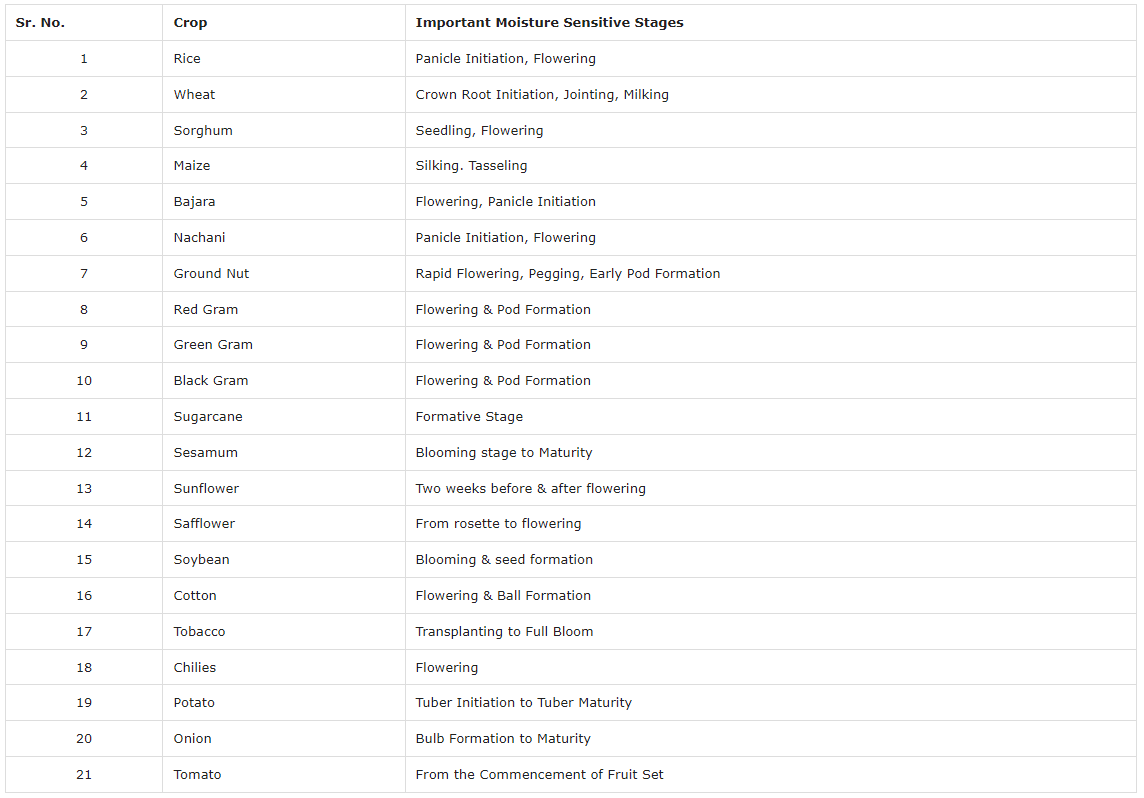Criteria for Scheduling Irrigation or Approaches for Irrigation Scheduling | NABARD Grade A & Grade B Preparation - Bank Exams PDF Download
| Table of contents |

|
| Introduction |

|
| Soil moisture depletion approach |

|
| Plant-Based or Plant Indices |

|
| Climatological Approach |

|
| Critical Growth Approach |

|
| Plant water status it self |

|
Introduction
A well-planned irrigation schedule should specify both the timing and the amount of irrigation water to be applied. Various methods for scheduling irrigation have been employed by both scientists and farmers.
Soil moisture depletion approach
To determine when to schedule irrigation, it's essential to assess the available soil moisture within the root zone, which varies for different crops. When the soil moisture in a specified depth of the root zone reaches a specific level, it needs to be replenished through irrigation.
For practical purposes, it's recommended to begin irrigation when about 50% of the available moisture in the soil root zone has been depleted. The available water represents the soil moisture that falls between field capacity (the maximum water the soil can hold) and wilting point (the point at which the crop starts to suffer). The relative availability of soil moisture varies between field capacity and wilting point, and since crops begin to experience stress before reaching the wilting point, it's essential to determine the optimal point within the available soil moisture range when irrigation should be scheduled to maintain high crop yields.
Soil moisture deficit represents the difference in moisture content between field capacity and the point before irrigation. This is typically measured in terms of factors like percentage, availability, tension, and resistance.
Plant-Based or Plant Indices
Plants can be used as a guide for irrigation scheduling since they are the end-users of water. Water deficit in plants is often indicated by visible signs like drooping, curling, or rolling of leaves, and changes in foliage color, which serve as indicators for when irrigation is needed. However, these signs signify the need for water but do not provide a quantitative estimation of moisture deficit.
Various growth indicators, including factors like cell elongation rates, plant water content, leaf water potential, plant temperature, and leaf diffusion resistance, are utilized to decide when irrigation should be applied. In some cases, specific indicator plants, like sunflowers used to estimate the Permanent Wilting Point (PWP) of the soil, serve as a basis for scheduling irrigation. For example, sunflower plants are used in Hawaii as indicator plants for irrigation in sugar cane cultivation.
Climatological Approach
Evapotranspiration is predominantly influenced by climatic conditions. The amount of water lost through evapotranspiration is estimated using climatological data, and irrigation is scheduled when evapotranspiration reaches a certain level. The amount of irrigation provided can be equal to evapotranspiration or a fraction of it. Different methods within the climatological approach include the IW/CPE (Irrigation Water to Cumulative Pan Evaporation) ratio method and the pan evaporimeter method.
In the IW/CPE approach, a known quantity of irrigation water is applied when cumulative pan evaporation (CPE) reaches a predetermined level. The irrigation amount typically ranges from 4 to 6 cm, with 5 cm being the most common. Irrigation is often scheduled at an IW/CPE ratio of 1.0, with 5 cm of irrigation. Typically, irrigation is administered at ratios of 0.75 to 0.8, along with 5 cm of irrigation water.
Critical Growth Approach
In various crops, certain growth stages are particularly sensitive to moisture stress, and experiencing moisture deficiency during these stages can result in irreversible yield losses. These specific stages are referred to as critical periods or moisture-sensitive periods. When there is an ample supply of irrigation water, the irrigation schedule is set to replenish soil moisture when it depletes to critical moisture levels, typically around 25 or 50 percent of the available soil moisture. However, when water availability is limited, irrigation is planned during moisture-sensitive stages and omitted during non-sensitive stages. In the case of cereal crops, panicle initiation, flowering, and pod development are the most crucial moisture-sensitive stages.
Table: Moisture sensitive stages of important crops
Plant water status it self
This is the most recent method for determining when to schedule irrigation. Plants serve as reliable indicators of soil moisture and climate conditions. The water content within the plant is taken into account when planning irrigation. However, it has not yet become widely adopted due to the lack of standardized and cost-effective techniques for measuring the plant's water status or potential.
|
847 videos|1297 docs|420 tests
|
FAQs on Criteria for Scheduling Irrigation or Approaches for Irrigation Scheduling - NABARD Grade A & Grade B Preparation - Bank Exams
| 1. What is the soil moisture depletion approach for irrigation scheduling? |  |
| 2. What are plant-based or plant indices in irrigation scheduling? |  |
| 3. How does the climatological approach help in irrigation scheduling? |  |
| 4. What is the critical growth approach to irrigation scheduling? |  |
| 5. How can plant water status be used as a criterion for irrigation scheduling? |  |















